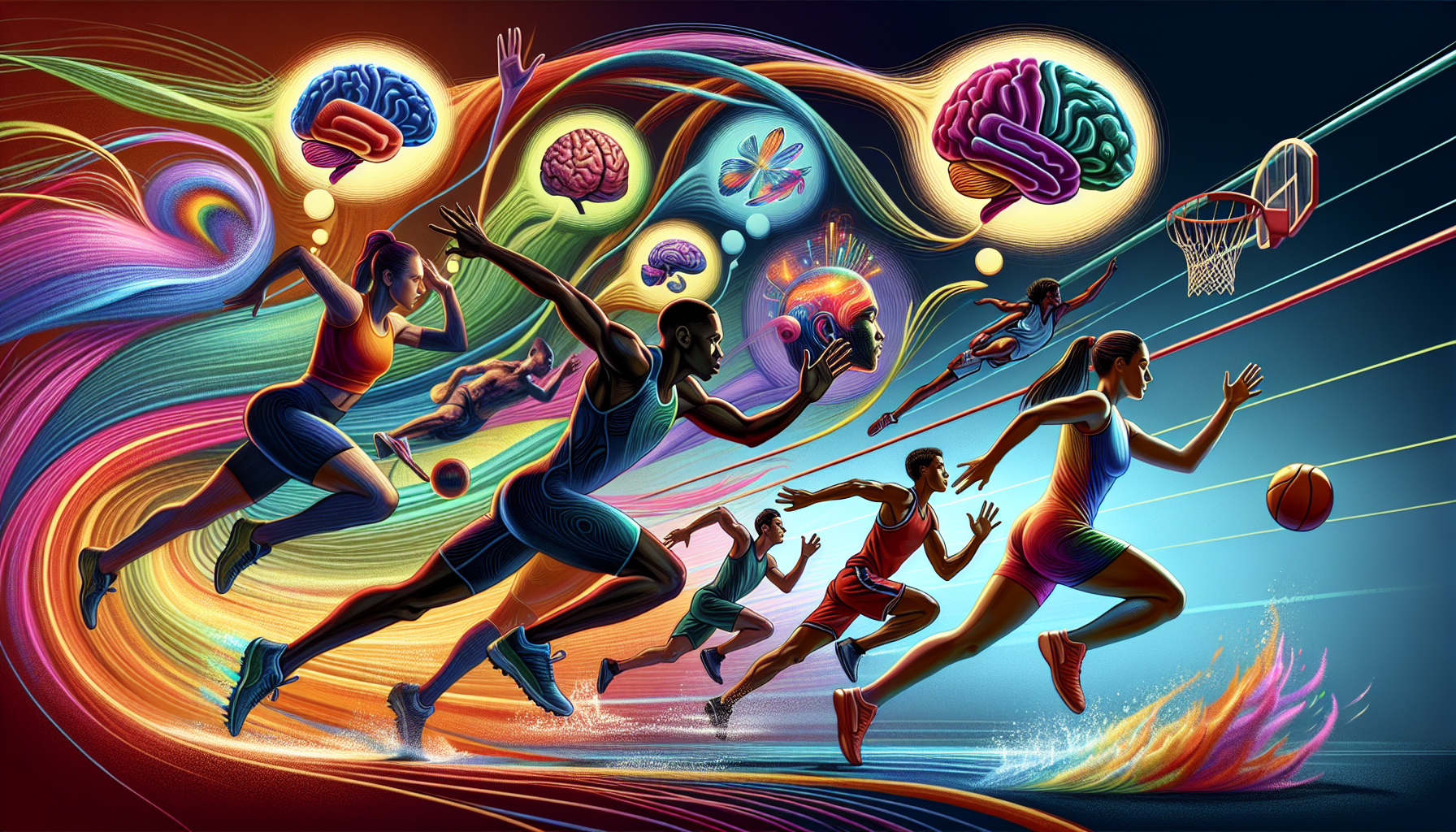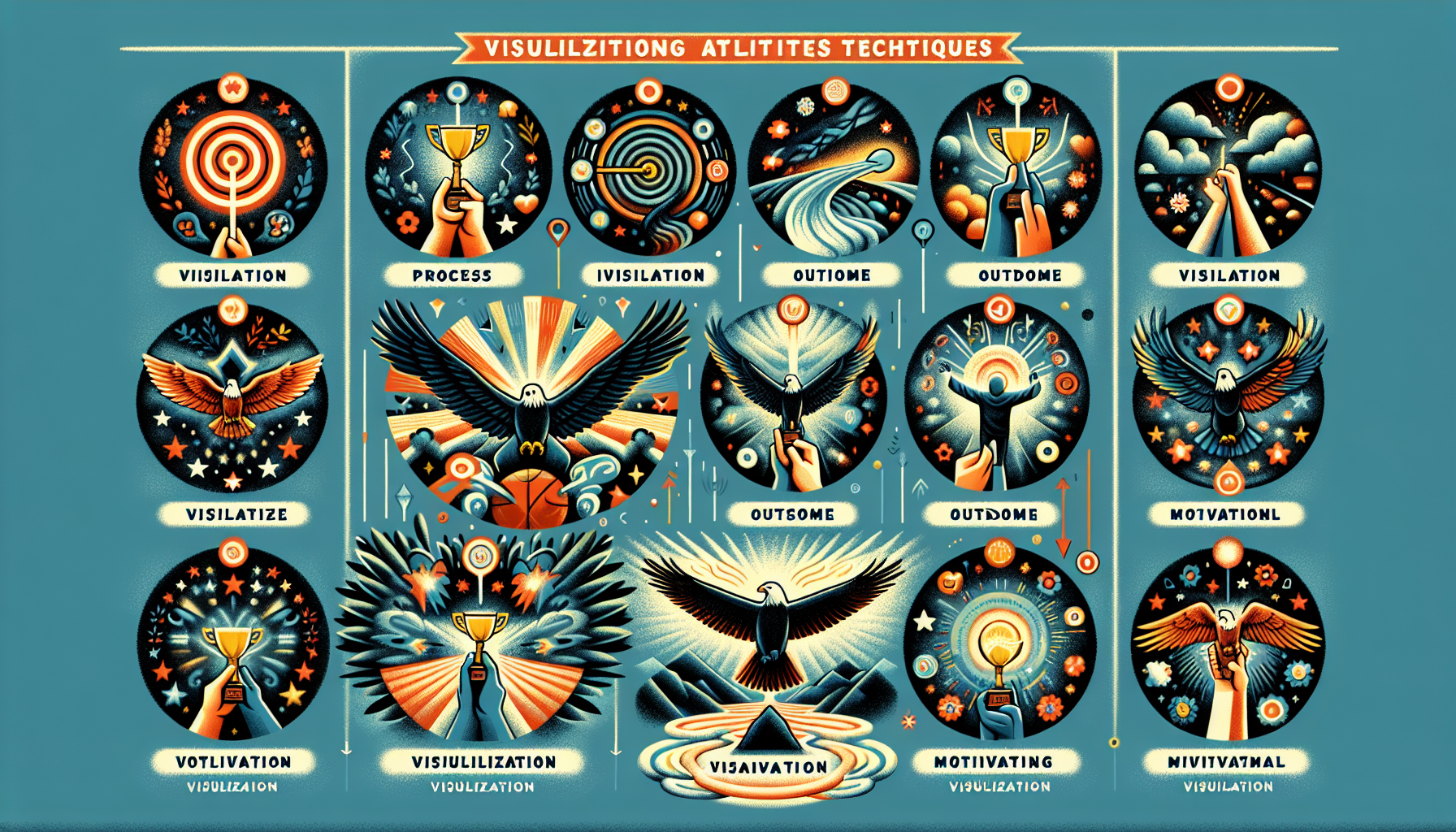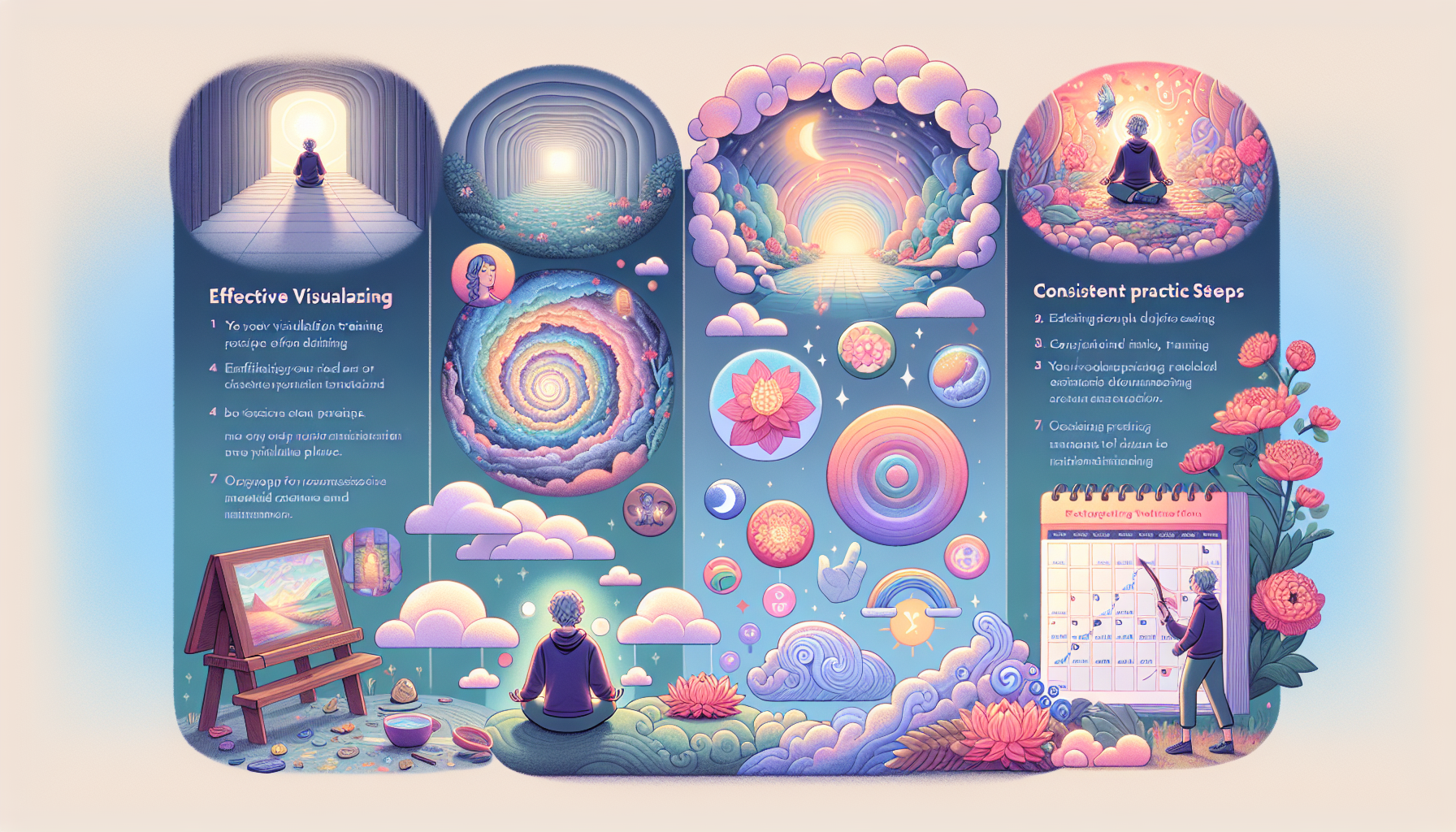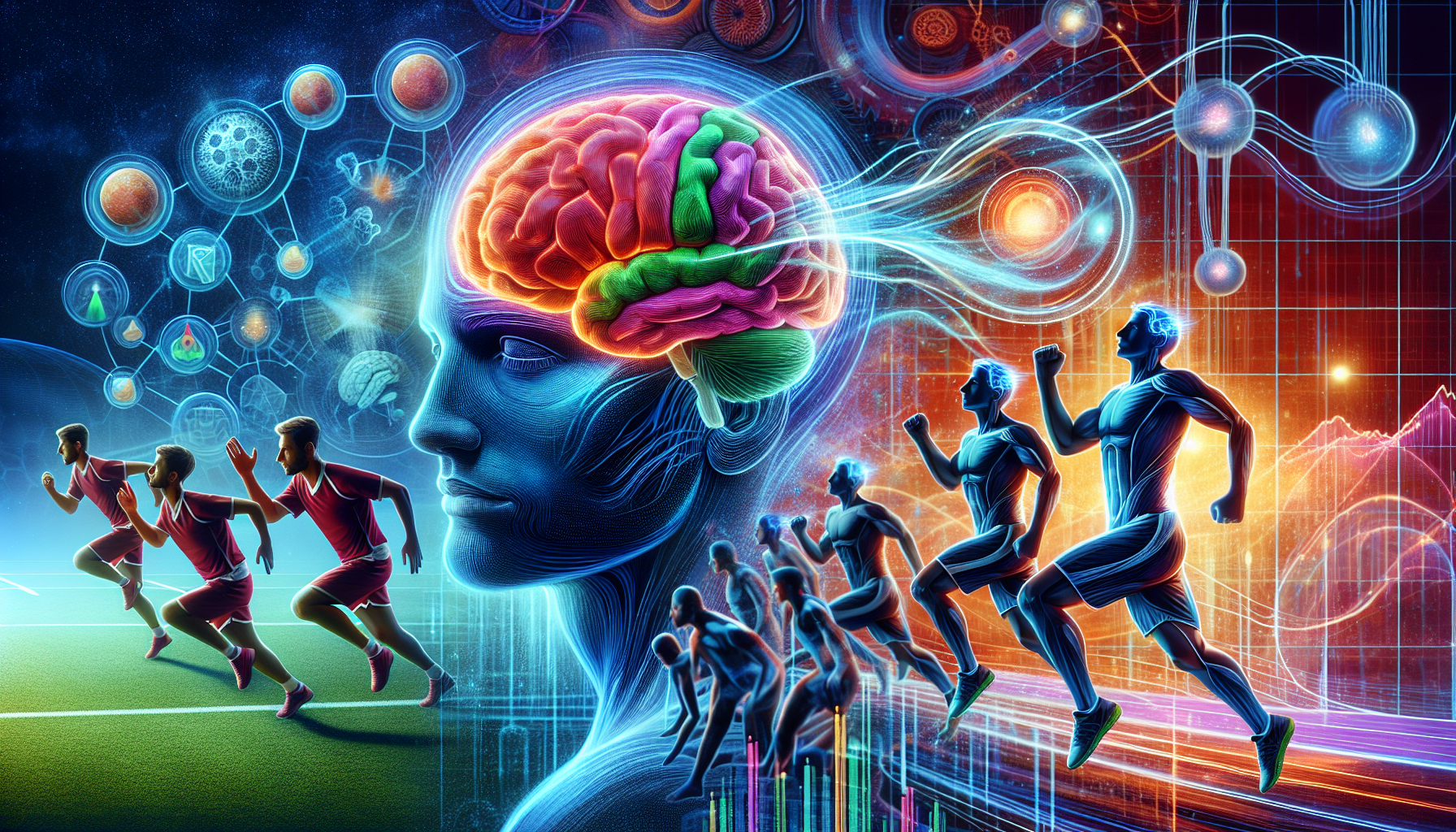3 Powerful Visualization Training Tips!

What is Visualization Training: Benefits and Techniques Explained
Visualization training is a mental technique where you create detailed mental images to improve performance and achieve specific goals. Commonly used by athletes and professionals, it helps in mentally rehearsing actions and boosting confidence. In this article, we’ll explain what visualization training is, explore its benefits, and look at the techniques you can use to enhance your abilities.
Key Takeaways
- Visualization training involves creating detailed mental images to prepare for actions and improve performance, benefiting athletes and professionals alike.
- Different techniques—such as process, outcome, and motivational visualization—can enhance focus, confidence, and execution in various scenarios.
- Regular practice and integration of visualization into daily routines not only bolster physical skills but also provide psychological benefits like increased confidence and reduced anxiety.
Understanding Visualization Training

Imagery training, commonly referred to as visual mental imagery, entails the generation of mental images for rehearsing specific actions or behaviors. This practice is instrumental in augmenting performance across a range of disciplines by allowing individuals to mentally simulate physical tasks. Imagery training extends beyond mere visualization by incorporating additional sensory experiences and forms an integral part of mental skills training utilized by both athletes and professionals to enhance their capabilities.
To appreciate the full scope and impact of this technique, it’s important to delve into the various methods associated with visualization training and acknowledge how these practices have advanced over time. With roots that can be traced back through history, today’s use in sports psychology represents a complex instrument designed to harness the power of our brain’s visual system—a means crafted precisely for boosting performance through systematic mental practice processes.
What is Visualization Training?
The process of visualization involves the mental simulation of specific experiences with an objective to influence a particular result. It differs from mere imagination in its methodical nature, designed specifically for rehearsing favorable scenarios. When individuals engage in this practice, they activate similar neural connections within the brain as those utilized during actual activities. Thus, it serves as an effective strategy to prepare both mentally and physically for real-life situations.
Visualization techniques encompass generating vivid images that depict triumphs through a first-person perspective—encompassing everything from executing sports maneuvers to delivering business presentations or achieving personal milestones. This visual exercise is particularly useful because it provides clarity and boosts confidence by transforming abstract ambitions into concrete, attainable objectives.
By envisaging their success beforehand, athletes and professionals can mentally walk through their anticipated endeavors, which ultimately contributes positively towards their real-time performance when under pressure.
History and Evolution of Visualization Training
Visualization techniques have their origin in age-old customs where mental practice was a component of numerous spiritual and cultural rites. These traditions have been honed over the centuries, ultimately integrating into contemporary areas like sports psychology, enabling athletes to mentally visualize their performance as a means to boost both their proficiency and self-assurance.
Presently, visualization is recognized as an extensively utilized and sophisticated instrument within various sectors for facilitating optimal performance. This form of mental training has become essential for many aiming at reaching the pinnacle of success in their endeavors.
Types of Visualization Techniques

Training in visualization involves a range of strategies, each offering distinct advantages and suited for different uses. Key techniques comprise visualizing the process, envisioning the outcomes, and fostering motivational imagery. These practices enable people to concentrate on various elements of their performance: from envisaging the precise actions necessary to accomplish an objective to harnessing emotional momentum needed for sustained motivation.
Grasping these methods is beneficial as it assists you in selecting an appropriate technique tailored to your individual or business-related requirements.
Process Visualization
The practice of process visualization entails picturing the intricate steps and motions necessary to carry out a certain skill. Through the act of imagining these elements in vivid detail, people can boost their mastery and application of skills. This method is exceptionally beneficial for athletes as it enables them to mentally go through complex actions, fine-tuning their technique without engaging in physical activity.
For practitioners visualizing a task execution, maintaining high levels of specificity and concentration is essential. They need to visualize each step clearly, from movement patterns down to specific sensations linked with the performance at hand. Immersing themselves in such depth fosters muscle memory and builds confidence that primes the body for real-world implementation.
Regularly employing process visualization supports individuals striving towards elevating their capabilities – aiding them significantly on their path toward achieving peak performance outcomes.
Outcome Visualization
Visualization of the desired outcome centers on creating a mental image of the target achievement. This method boosts motivation and clarifies goals by allowing individuals to envision their triumph in clear, detailed imagery. Top-tier athletes regularly utilize visualization that engages all senses, crafting a comprehensive and tangible mental practice session.
By conjuring up an image of success—such as imagining oneself breaking the tape at the finish line or executing a perfect presentation—the focus is sharpened and resolve fortified. Beyond enhancing drive, this technique also aligns one’s actions with their objectives, rendering victory more within reach.
Employing outcome visualization serves as an effective strategy for any individual aiming to realize specific ambitions while maintaining distinct foresight concerning their anticipated accomplishments.
Motivational Visualization
The practice of motivational visualization is aimed at boosting motivation and fortifying mental strength through the creation of mental images that evoke feelings like confidence and resilience. Engaging in this method aids individuals in maintaining their drive and fostering a more optimistic attitude, propelling them toward achievement. The act of visualizing oneself surmounting obstacles and accomplishing objectives reinforces psychological resilience and determination.
This approach entails forming vivid imagery that invigorates self-assurance and constructive thought patterns. When individuals engage in envisioning powerful, affirmative emotions, they can amplify their concentration and involvement, which subsequently elevates performance levels.
Motivational visualization serves as an invaluable instrument for those who aspire to enhance their psychological robustness while nurturing a positive state of mind even when confronted with challenging situations.
How Visualization Training Works
Training in visualization involves the activation of several brain regions, notably the primary visual cortex, in a manner similar to actual viewing experiences. The brain is not capable of distinguishing between genuine activities and those conjured up through imagination, as both invoke comparable neural pathways. Consequently, this process transforms visualization into an effective mental practice wherein creating vivid images of anticipated results serves to devise practical steps toward achieving them.
In the realm of sports, employing visualization does more than just bolster athletic performance. It also provides athletes with a tool for anxiety control by acquainting them with competitive situations ahead of time.
Neural Pathways and Brain Plasticity
Visualization activates the same neural pathways in the brain that are involved when performing physical tasks, essentially readying the body for actual performance. By intensely visualizing activities, we enhance these pathways through consistent mental practice. The brain’s ability to modify itself through this type of exercise is referred to as brain plasticity and it facilitates better execution of motor skills.
Through continual visualization practice, certain neural pathways become reinforced, resulting in enhanced motor skill proficiency and overall performance. This kind of mental preparation strengthens the bond between mind and body, leading to more precise and effective action execution when required.
Mental Imagery and Motor Skills
Mental imagery is pivotal in guiding actions influenced by perceptual states or recalled experiences, playing a vital role in the improvement of motor skills. Recent research indicates that visual mental imagery functions much like a diminished form of actual seeing. This process can positively impact one’s ability to perform tasks. Enhanced outcomes and upgraded motor skill proficiency result from maintaining intricate and specific mental representations while engaged in visualization training.
Distinguished from general approaches to mental imagery, motor imagery focuses on the preparation and implementation of action plans. It involves imagining with detail the necessary movements for executing a particular task, thereby fostering muscle memory and enhancing coordination.
To boost their effectiveness during training for improved motor skills performance, individuals should adopt multi-sensory strategies that expand upon traditional single-sense methods.
Emotional Conditioning
By employing visualization techniques, individuals can instill emotions such as confidence and resilience to bolster mental fortitude. This technique is potent for controlling anxiety associated with performance and boosting self-assurance. Visualizing affirmative emotional states amplifies optimism and engenders a feeling of tranquility, which translates into superior performance in high-pressure situations.
Through the consistent practice of visualization, one can train their emotional reactions to promote mental robustness. Visualization helps reduce stress levels and heighten concentration during competition. As a result of this emotional conditioning through visualization exercises, it becomes an influential instrument for advancing both cognitive function and physical prowess.
Practical Steps for Effective Visualization Training

To achieve the full advantages of visualization training, it’s essential to follow a methodical strategy and maintain regular practice. The critical steps are as follows:
- Establishing a tranquil space
- Employing vivid imagery
- Incorporating emotions into the visualizations
- Ensuring frequent repetition for consistency
Adhering to these guidelines can significantly enhance the effectiveness of visualization exercises and support individuals in reaching their personal and professional aspirations.
Creating a Calm Space
Creating a dedicated space that is quiet and free from interruptions is crucial for practicing visualization effectively to ensure maximum focus. To improve the concentration during these sessions, it’s important to minimize external distractions within this dedicated area. Incorporating mindfulness techniques can greatly boost the ability to focus while engaging in visualization exercises.
Utilizing deep breathing methods can also aid in calming the mind and bolstering focus throughout visualization practices. Maintaining a tranquil atmosphere within this space is key to conducting successful visualization practices and obtaining optimal outcomes.
Detailed Imagery
Utilizing detailed mental imagery techniques is essential in visualization training, enabling individuals to create vivid visual representations of the nuanced aspects of a skill. By mentally practicing the precise actions and motions required for skill execution, one can improve their physical performance. The use of all five senses within this practice greatly increases both realism and efficiency in these mental images.
Incorporating sensory elements like auditory cues and olfactory sensations can amplify the definition of mental images during visualization exercises. When several senses are engaged concurrently in such practices, it not only bolsters the sharpness but also intensifies the vibrancy of one’s mental imagery, making each practice session more effective.
By merging intricate visual imagery with multisensory engagement, practitioners achieve superior outcomes as these enriched visualizations become more life-like and thus easier to recall. This combination ultimately boosts performance by ensuring that imaginings used during training sessions are as realistic as possible.
Integrating Emotions
The inclusion of emotions significantly boosts the effectiveness and retention power of visualization. By charging the experience with potent emotions, one heightens focus and engagement, which leads to improved results.
Embedding feelings into the practice of visualization not only increases its pleasure, but also aids in better memory preservation of the information visualized.
Repetition and Consistency
Regular engagement in visualization techniques is critical for enhancing the neural pathways associated with specific skills or anticipated results. Olympic athletes frequently incorporate mental imagery into their routine training schedules, using it as a daily tool to gear up for significant events. By dedicating brief periods of focus to distinct images, practitioners can markedly enhance the sharpness of their mental images.
The efficacy of visualization training hinges on persistent and steady repetition. Through ongoing practice of imagery, individuals solidify neural connections which contribute to incremental improvements in performance over time.
Integrating Visualization into Daily Routine
Creating a consistent schedule for visualization practice can greatly improve its impact. Working with coaches and mentors, setting aside designated times for mental imagery exercises, and blending these practices with actual physical training are crucial components of incorporating this technique into everyday life.
Incorporating visualization consistently as part of your routine leads to ongoing enhancements in both mental prowess and athletic performance.
Scheduling Visualization Sessions
Allocating designated periods for visualization exercises as part of your training regimen fosters discipline and sharpens focus, which in turn contributes to better performance. The regular commitment to these visualization sessions can cultivate a habit that enhances outcomes.
Establishing a routine time slot for engaging in visualization practices allows it to become a potent habitual activity, thereby facilitating the attainment of your objectives.
Collaborating with Coaches and Mentors
Partnering with coaches or mental performance consultants is essential to customize visualization practices effectively, ensuring they are aligned with the unique needs and aspirations of individuals. By involving mentors in this process, athletes can develop personalized strategies that integrate visualization techniques into their specific athletic objectives, allowing for tailored adjustments according to individual performance targets.
Enhancing one’s approach to visualization through the expertise of seasoned coaches facilitates a more targeted alignment with distinct performance goals.
Combining with Physical Training
Incorporating visualization techniques into traditional training can lead to a significant improvement in performance, with potential enhancements of up to 45%. It’s vital for athletes to merge these mental practices with their physical regimen for an all-encompassing strategy aimed at boosting performance.
Such an integrated approach not only aids in refining skills, but also provides psychological advantages, leading to a marked increase in athletic prowess.
Scientific Evidence Supporting Visualization Training

Research in the scientific community validates the efficiency of visualization training, indicating that combining physical practice with mental imagery contributes to enhanced skill retention and performance improvement. Evidence has shown that through the application of imagery techniques, neural activation is heightened, performance levels are elevated, and psychological advantages are attained—including a rise in confidence as well as diminished anxiety.
Research on Neural Activation
Training through visualization stimulates the same regions of the brain that are active during actual motor execution. Due to the fact that the brain treats imagined activities and real ones as virtually identical, this results in comparable patterns of neural activity. Through repeated use of visualization, athletes can strengthen certain neural connections, thereby enhancing their motor skills and overall performance.
The concept of brain plasticity enables athletes to shape their neural networks by engaging consistently in visualization exercises. This underscores how potent a method it is for using neural activation to boost an athlete’s performance—making it a valuable addition to physical training regimens.
Studies on Performance Improvement
The practice of visualization employs mental imagery to activate the same brain networks involved in actual physical training, thereby bolstering sports performance. Research suggests that by visualizing their movements, athletes can improve motor skills and achieve gains similar to those gained through tangible practice sessions.
Several accomplished athletes credit their success to routine utilization of such visualization strategies which allow for mental rehearsal and optimization of performance. Notable sports figures, including Michael Phelps, consider guided imagery a vital component in their regimen—meticulously envisaging triumphant outcomes as part of their strategic preparations.
Psychological Benefits
Athletes who routinely employ visualization techniques can strengthen their motivation and build up their self-assurance. The psychological advantages of visualization training are noteworthy, especially with respect to boosting confidence levels and diminishing feelings of anxiety.
Such advantages position visualization as an instrumental resource for amplifying mental fortitude and enhancing overall performance.
Common Challenges and Solutions in Visualization Training
Even though visualization training offers numerous advantages, individuals may encounter certain hurdles including struggling to focus, creating clear mental images, and surmounting negative emotions.
Recognizing these typical difficulties and adopting successful strategies can enhance the rewards of engaging in regular visualization exercises.
Difficulty in Concentration
Enhancing the ability to focus is essential for successful visualization training, as it allows individuals to concentrate on their mental imagery. Distractions can detract from effective visualization, thus requiring methods to bolster concentration. Strategies such as eliminating distracting thoughts and fostering a serene environment devoid of disturbances help in honing this skill.
To boost concentration while engaging in visualization exercises, it’s beneficial to employ tactics that reduce distractions and sharpen one’s proficiency at creating vivid mental images. Possessing the knack not just for visualizing but also for selectively tuning out irrelevant visuals can significantly improve the ability to fixate on pivotal mental images during these sessions.
Vividness of Mental Images
The creation of clear and detailed mental imagery is a fundamental component in successful visualization exercises, as it intensifies the clarity and reinforces the bond between mind and body. When one concentrates on generating vivid imagery that encompasses intricate details across all senses, the practice of visualization becomes more lifelike and effective.
To forge an experience that is both powerful and enduring during visualization, it’s vital to weave emotions into your imagined scenarios. Consistent application and dedication to regularly training your ability to visualize are crucial for developing highly vivid and precise mental images.
Overcoming Negative Emotions
Utilizing positive affirmations to transform negative thoughts into constructive ones can alleviate the detrimental feelings that arise during visualization. Engaging in regular affirmation practices can neutralize the impact of negative emotions encountered in visualization, fostering a more affirmative mental state.
Concentrating on favorable scenarios and continuously strengthening upbeat notions are effective strategies for dispelling any pessimistic sentiments that emerge throughout imagery exercises. This approach assists individuals in surpassing adverse emotional responses and preserving an optimistic attitude during their practice of visualization.
Visualization Training in Sports Psychology

In the realm of sports psychology, mental imagery is a crucial technique employed by athletes to conjure up vivid images depicting successful outcomes with the aim of boosting their performance. This practice underscores the significance of focus, self-assurance, and fine tuning physical abilities through mental visualization.
Both coaches and athletes are aware that for optimal results in performance, it’s essential to incorporate training in mental skills along with routine development of physical prowess. Mental skill encompasses an integral component that contributes greatly to success on the playing field.
Enhancing Athletic Performance
Utilizing visualization techniques can bolster athletic performance by allowing athletes to engage in mental practice. By envisioning the outcomes they desire, such as securing victories or surpassing personal records, athletes reinforce their drive and elevate their overall performance.
Studies have shown that there are tangible improvements in skill execution among athletes who incorporate visualization into their training regimen. This form of mental imagery helps refine athletic abilities and contributes to a more robust overall performance. These individuals often report an increased sense of self-efficacy along with notable enhancements in executing the skills required for their sport.
Mental Skills Training for Elite Athletes
Research indicates that athletes and professionals who engage in visualization see considerable enhancements in their performance, confirming the utility of such techniques. By incorporating visualization into their training regimen, these individuals can refine their skills, hone strategic thinking, and elevate overall athletic prowess.
Case studies from actual athlete experiences underscore how employing visualization tactics has played a pivotal role in competitive triumphs. These instances demonstrate the efficacy of mental skills training for reaching peak sports achievement and emphasize the critical nature of integrating regular visualization exercises into daily practice routines.
Case Studies and Success Stories
Elite athletes often experience considerable enhancements in their strategic skills and overall performance when they integrate visualization techniques into their training regimens. The mental aspect of their game shows notable progress, as reported by many at the top levels of competition.
Athletes hailing from various sporting arenas, such as Olympic champions and professional contenders, have routinely adopted visualization as a critical component of their training strategies to achieve optimal performance.
Summary
In essence, the practice of visualization utilizes the brain’s capacity to craft detailed mental images that boost performance levels. Through mastering various visualization techniques and applying them appropriately, one can customize their training routine to meet precise objectives. Establishing a serene environment, employing intricate imagery with emotional depth, and ensuring regularity are all crucial components for successful visualization practice.
The advantages of engaging in visualization training are extensive. It not only improves motor skills and overall performance, but also strengthens emotional robustness and self-assurance. By incorporating this form of mental rehearsal into your everyday regimen in partnership with coaches—and harmonizing it with physical exercises—you have the potential to tap into your ultimate abilities and secure triumphs both personally and professionally.
Frequently Asked Questions
What is visualization training?
Visualization training is all about using your imagination to create mental images that help you rehearse and improve your skills, whether in sports, performance, or any other area. It can be a powerful tool for boosting your confidence and enhancing your abilities.
How does visualization training work?
Visualization training activates brain areas in ways similar to real visual experiences, making it a powerful tool for planning and achieving goals. By mentally rehearsing, you can improve performance and confidence in your desired activities.
What are the different types of visualization techniques?
There are many visualization techniques, like process, outcome, and motivational visualization, each highlighting unique performance aspects.
Choosing the right one can really boost your focus and effectiveness!
How can I integrate visualization into my daily routine?
Integrating visualization into your daily routine is simple: just set specific times for practice and combine it with your physical training.
This way, you can enhance your mental game effectively!
What are the benefits of visualization training?
Visualization training can significantly boost your motor skills and performance while also increasing your confidence and reducing anxiety.
It’s a great tool for enhancing emotional resilience as well.


